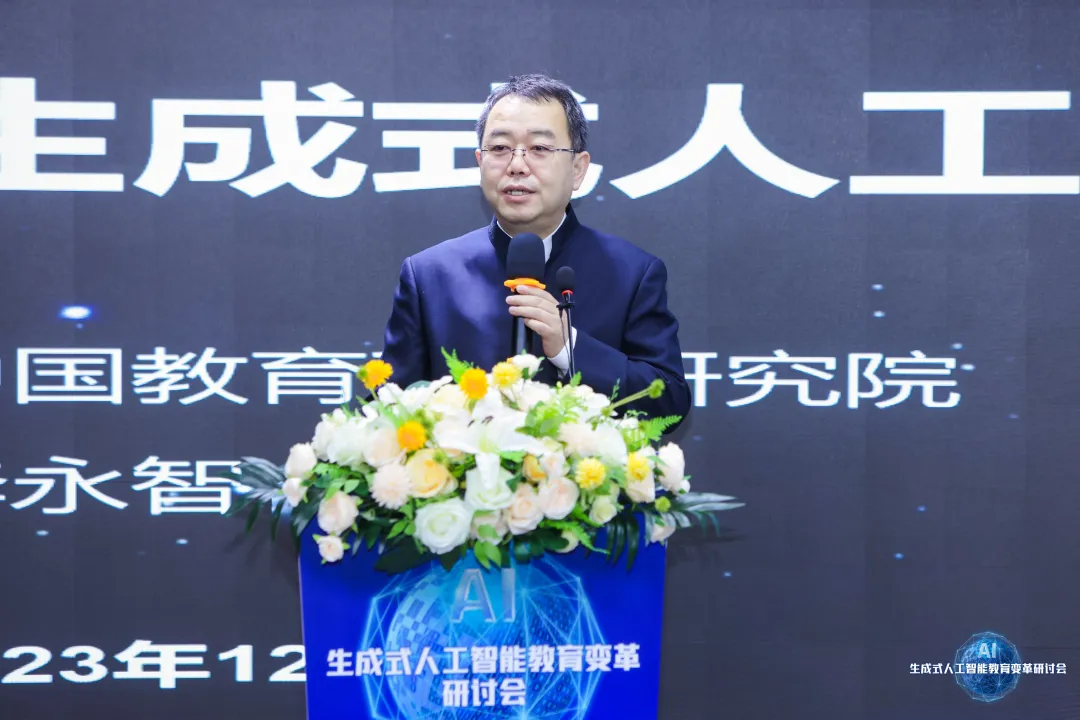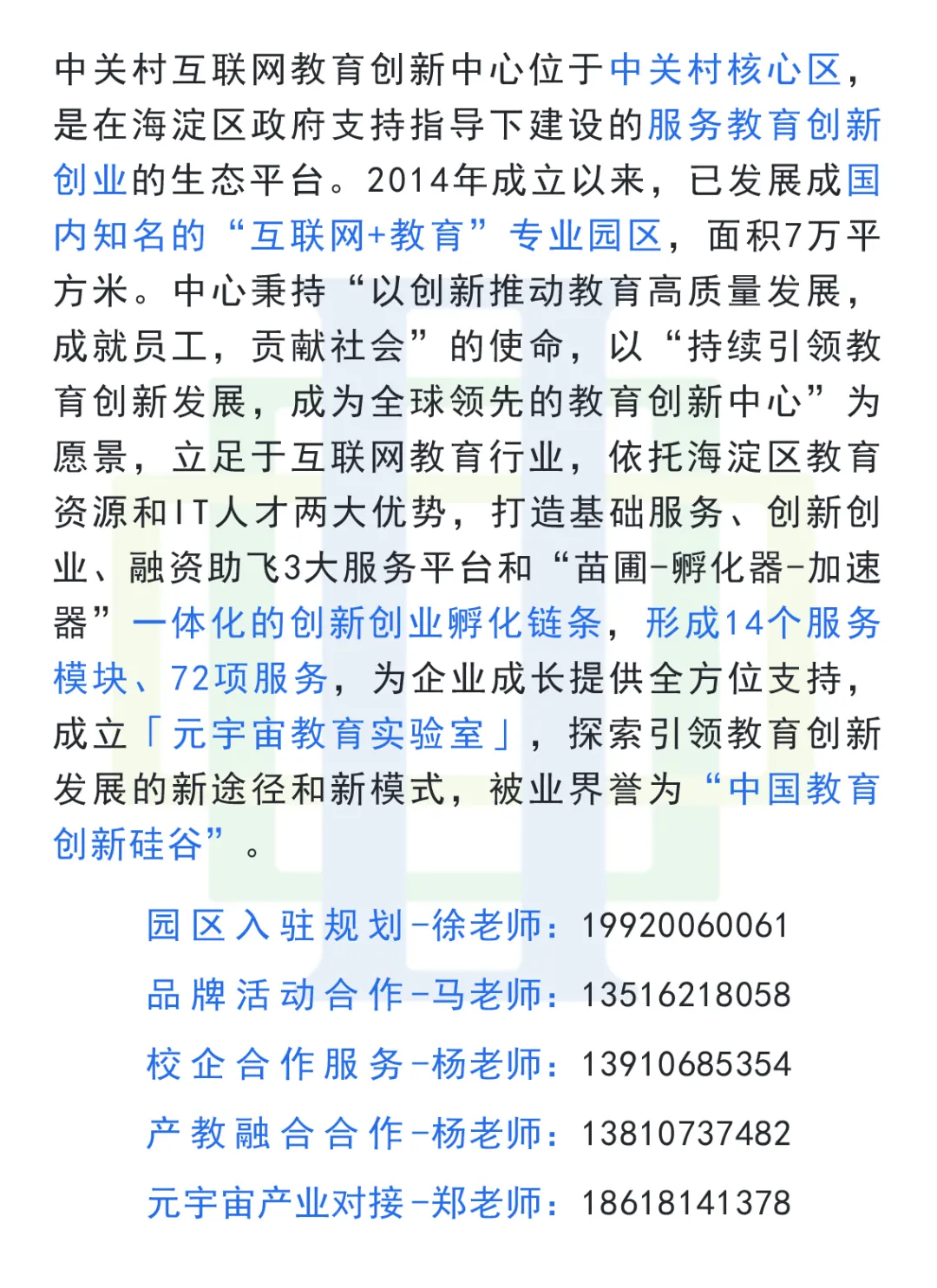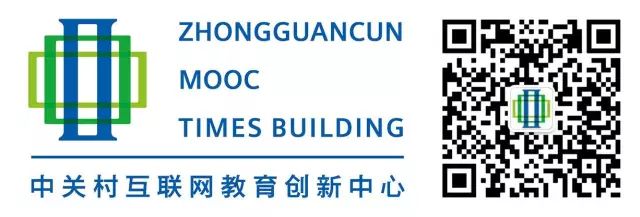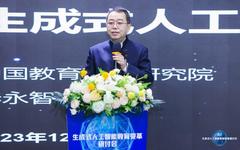Since the birth of ChatGPT in November 2022, this wave of “technology wind” has been sweeping through the education sector. Many students are already using generative artificial intelligence technology to help them complete their homework, and many teachers are also trying to use it to improve the quality of their lesson plans and teaching levels. People are both curious and worried about the trend of integrating this new technology with education: how should we view new technologies? What impact will this new technology have on today’s education?Li Yongzhi, Secretary of the Party Committee and President of the Chinese Academy of Educational Sciences believes that teachers and students should maintain a positive, open, and cautiously discerning attitude towards new technologies. Let’s take a look—

Li Yongzhi, Secretary of the Party Committee and President of the Chinese Academy of Educational Sciences
 We should critically view generative artificial intelligence technology
We should critically view generative artificial intelligence technology
In an era of breakthrough development in generative artificial intelligence technology, the division of labor, forms of social production, and production relations are likely to undergo greater changes. Some scholars predict that by 2026 or some time later, certain jobs may be replaced by artificial intelligence. Such predictions will undoubtedly directly compel further optimization and reform of educational models. Because if people find that the knowledge and skills they have learned are difficult to adapt to the needs of society at that time, they will question education and even increase social instability. In the face of the new situation, an important premise is: we should critically view generative artificial intelligence technology.
I believe,current technology is not mature enough to be systematically, comprehensively, and accurately applied in teaching, and overemphasizing the application of artificial intelligence technology in the micro-environment of education may be premature. Teachers must first recognize the limitations of this technology. Generative artificial intelligence currently lacks a judgment on “capability boundaries”; for questions it cannot answer, it provides answers based on probability, which may often contain errors. In this case, teachers should focus on guiding students to enhance their understanding of the essence of generative artificial intelligence technology and its preliminary applications. Teachers can generate necessary graphic stories or videos through generative artificial intelligence technology during the teaching process, enhancing their lesson design and teaching organization capabilities, increasing classroom interactivity, thereby improving educational outcomes, rather than treating new technology as a primary teaching tool.
 Enhancing Students’ Higher-Order Cognitive Abilities and the Combined Application Ability of Complex Skills
Enhancing Students’ Higher-Order Cognitive Abilities and the Combined Application Ability of Complex Skills
Teachers must change their mindset and guide students to learn knowledge and skills that artificial intelligence cannot master. Compared to the past, less energy should be spent on knowledge that can be mastered merely through repetition, and more time should be allocated to teaching important thinking and skills.This requires teachers to genuinely shift from the traditional “teacher-centered” approach to a “student-centered” approach, focusing on cultivating students’ abilities to identify problems, analyze problems, and solve problems, thereby developing their ability to pose real questions and construct knowledge.
More importantly, enhancing students’ higher-order cognitive abilities and the combined application ability of complex skills are two capabilities that generative artificial intelligence currently lacks. At the same time, to help students better cope with potential changes in future employment, teachers should also cultivate students’ ability to collaborate with “strong artificial intelligence” to complete tasks, enhancing the collective resilience of future nation-builders in the face of disruptive technological advancements. To truly cultivate students’ literacy in generative artificial intelligence technology, teachers must first guide students to enhance their ability to ask questions about this new technology. In the process of questioning, students can seek information that logically aligns with their ultimate goals from the answers provided by artificial intelligence each time, gradually delving deeper, and finding the accurate information they want through continuous inquiry. Managing the Use of Generative Artificial Intelligence for Primary and Secondary Students
Managing the Use of Generative Artificial Intelligence for Primary and Secondary Students
Improper use of generative artificial intelligence technology by students needs to be particularly guarded against.If students rely too much on it, it may lead to inertia and damage to their thinking ability, creativity, and learning motivation. For example, when writing essays, if students are accustomed to listing the viewpoints or structure of the article and leave the remaining steps to generative artificial intelligence, over time, they may lose the ability to produce long texts and be unable to independently complete an article. Essentially, as students, to have survival and competitiveness in future society, they need to possess abilities that surpass those of generative artificial intelligence, such as using emotional intelligence and interdisciplinary knowledge to write high-quality long texts; applying critical thinking and collaborative problem-solving skills to complete a task project with peers.
In the basic education stage, parents and schools must enhance their awareness of prevention, shouldering the responsibility of supervision and guidance, and strictly control students’ use of generative artificial intelligence technology. Schools can use communication platforms to educate parents about relevant knowledge, introduce the current technological application development situation, and cultivate the concept of normative use of new technologies. Schools should timely organize teacher training and other work to guide teachers to correctly view new technologies and improve their digital education capabilities.
 Providing the Most Suitable Education for Everyone Whether through classrooms, practice, or technology to master knowledge and skills, all are forms of learning. Changing forms of learning does not necessarily weaken students’ real experiences. For example, when students learn about the geographical knowledge related to tropical rainforest climates, teachers can teach knowledge through lectures, lead students to practical experiences locally, or use technologies such as VR (Virtual Reality) and AR (Augmented Reality) to complete teaching. In terms of the goal of “enabling students to master knowledge about tropical rainforest climates,” the difference in effectiveness between the immersive experience provided by generative artificial intelligence technology and students’ local practical experiences may not be as significant as people imagine. On the contrary, generative artificial intelligence technology may even enhance students’ sense of experience. This is because many students do not have the conditions to practice locally; even if they are in a tropical rainforest, they can only feel the local environment, while technologies like VR or AR can provide panoramic experiences. For learning certain knowledge, if there is no need for practical experience, there is no need to overly emphasize and worry about the impact of new technologies. While we guard against new technologies potentially weakening interpersonal interactions and real experiences, we should not let them overshadow some advantages, such as the extension and growth of our cognitive abilities through new technologies.One of the greatest impacts of generative artificial intelligence technology on education is to provide each learner with more equitable learning opportunities, more modernized learning equality, and growth equality.True educational quality and balanced development do not mean that everyone spends the same amount of time learning the same content. In the past, some regions overly emphasized teaching averaging, which may not have been fair to some students.Providing the most suitable education for everyone is our pursuit and a higher-level goal for quality and balanced educational development.
Providing the Most Suitable Education for Everyone Whether through classrooms, practice, or technology to master knowledge and skills, all are forms of learning. Changing forms of learning does not necessarily weaken students’ real experiences. For example, when students learn about the geographical knowledge related to tropical rainforest climates, teachers can teach knowledge through lectures, lead students to practical experiences locally, or use technologies such as VR (Virtual Reality) and AR (Augmented Reality) to complete teaching. In terms of the goal of “enabling students to master knowledge about tropical rainforest climates,” the difference in effectiveness between the immersive experience provided by generative artificial intelligence technology and students’ local practical experiences may not be as significant as people imagine. On the contrary, generative artificial intelligence technology may even enhance students’ sense of experience. This is because many students do not have the conditions to practice locally; even if they are in a tropical rainforest, they can only feel the local environment, while technologies like VR or AR can provide panoramic experiences. For learning certain knowledge, if there is no need for practical experience, there is no need to overly emphasize and worry about the impact of new technologies. While we guard against new technologies potentially weakening interpersonal interactions and real experiences, we should not let them overshadow some advantages, such as the extension and growth of our cognitive abilities through new technologies.One of the greatest impacts of generative artificial intelligence technology on education is to provide each learner with more equitable learning opportunities, more modernized learning equality, and growth equality.True educational quality and balanced development do not mean that everyone spends the same amount of time learning the same content. In the past, some regions overly emphasized teaching averaging, which may not have been fair to some students.Providing the most suitable education for everyone is our pursuit and a higher-level goal for quality and balanced educational development.

Follow the Official Video AccountFor More Educational Information


Source丨Guangming Educator, Original Title “Li Yongzhi, President of the Chinese Academy of Educational Sciences: We Should Cautiously View AIGC’s Educational Applications,” with edits Reporter丨Qiao Dong, Wang Zilin Art Editor丨Ye Zi Proofreader丨Xi Bei Copyright Statement This article is a re-edited piece from the WeChat public account “Zhongguancun Internet Education Innovation Center (ID: zgc-mtb)”. The images added after editing are sourced from the internet. This public account is not responsible for the views expressed in the article, and it is shared for informational purposes only, providing no express or implied guarantees regarding the accuracy, reliability, or completeness of its content. The copyright of the article and images belongs to the original authors. If the shared content infringes your copyright, please contact us promptly, and we will review and handle it quickly.
 Share
Share Save
Save View
View Click
Click
